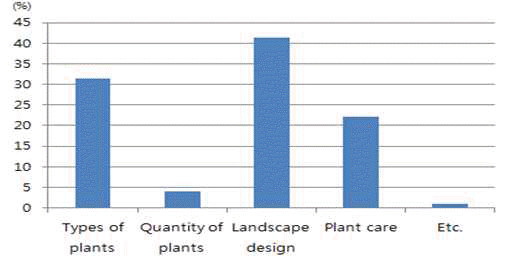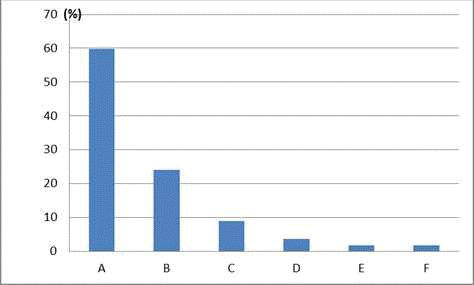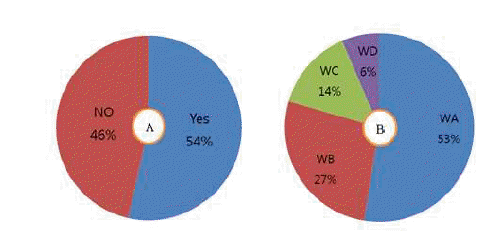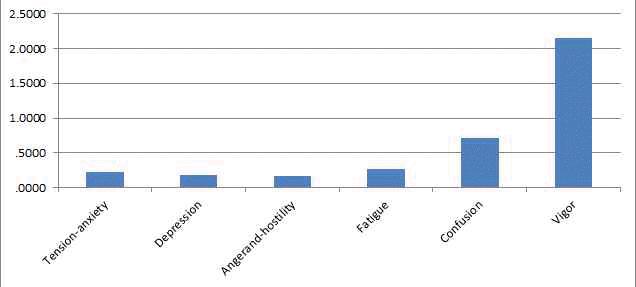Herzog TR, Maguire CP, Nebel MB. ŌĆ£Assessing the restorative components of environmentsŌĆØ. J. Environ. Psycho 2003;23(2): 159ŌĆō170.

Hwankyungilbo co. Ltd. Directing ŌĆśGreen healing officeŌĆÖ with 2% of office plants.
http://www.hkbs.co.kr 2014.
Im SB. Theories in landscape analysis. 2009;Revised ed. Seoul Natl. Univ., Press; Seoul, Korea.
Jang HS, Kim KJ, Jung HH, Khalekuzzaman M, Yoo EH. Effect of green interior office on emotional psychology of human. J. Korean Soc. People Plants Environ 2014;17:555ŌĆō560.

Jo KD. Development of environment-friendly streetscape design model consideting sensibility ergonomics. MS thesis. WonKwang Univ. Iksan. Korea 2008.
Kaplan R, Kaplan S. The experience of nature: A psychological perspective. 1989;Cambridge Univ., Press; New York.
Kim EI. A study of sight-psychological effects by a color area of greenspace. J. Kor. Inst. Landscape Architecture 1998;26(1): 36ŌĆō43.
Kim EN, Yun IG. Application of profile of the mood states(POMS) to study the mood state of workers dealing with manganese. Korean J. Occup Health 1998;37:5ŌĆō16.
Kim JH, Han HR. A study on introducing of green interior design for cultural space inside seoul subway station. Korean Interior of Interior Design Journal 2007;9:204ŌĆō209.
Kim JO. The impact of nature-based outdoor recreation settings on the healing tourists' attention restoration and quality of life: Focusing on the participants' at 'forest healing' program. PhD Diss. Hanyang Univ. Seoul. Korea 2015.
Kim KM. Study on the effects of forest healing according to types of recreational forests. PhD Diss. Chungbuk Natl. Univ. Cheongju. Korea 2012.
Kim NR. A study on the mood states through color stimulus of indoor landscape plants. MS thesis. Kyungsung Univ. Busan. Korea 2012.
Lee MS, Ka JN, Kim SA, Park MW, Lee JW, Park BJ. Effect of walking at the urban arboretums on psychological stability of male university students. J. Korean Soc. People Plants Environ 2011;14(5): 271ŌĆō277.
Lee SH. The comparisons of Urban, green roof, and forest scenes by ration psychological indices. Seoul City Research 2011;12(3): 53ŌĆō65.
Lee YH. A study on the factors of the external environment and environmental identity in apartments. Architectural Institute of Korea 1994;11:63ŌĆō73.
McNair DM, Lorr M. An analysis of mood in neurotics. J. Abnormal and Social Psycho 1964; 69:620ŌĆō627.

Oishi Y, Tatumi M, Tagguchi H, Murai H. Fundamental studies on the characteristics of electroencephalogram inspecting forest and grassland. J. Jap. Soc. Reveget. Tech 1996;21:212ŌĆō222.

OsgoodCE. The mature and measurement of meaning. Snider JG, Osgood CE. In: Semantic differential technique Chicago: IL, USA: Aldine Publishing Co; 1969.
Osgood CE, Suci GJ, Tannenbaum PH. The measurement of meaning. 1957;Univ. Illinois Press; Urbana. IL. USA.
Park BJ. Experimental approach of therapeutic effect of forest recreation activities. PhD Diss. Chungnam Natl. Univ. Daejeon. Korea 2010.
Park TE. A study on the user's attitude towards design criteria for healthy house. MS Thesis. Yonsei Univ. Seoul. korea 2004.
Richardson EA, Pearce J, Mitchell R, Kingham S. Role of physical activity in the relationship between urban green space and health. Public Health 2013; 27:318ŌĆō324.

Shibata S, Suzuki N. Effect of foliage plant on task performance and mood. J. Environ. Psycho 2002;22:265ŌĆō272.

Shin WS. The influence of forest view through a window on job satisfaction and job stress. Scandinavian J. For. Res 2007;22:248ŌĆō253.

Staats H, Kieviet A, Hartig T. ŌĆ£Where to recover from attentional fatigue: An expectancy-value analysis of environmental preferenceŌĆØ. J. Environ. Psycho 2003;23(2): 147ŌĆō157.

The Construction Economic Daily. ŌĆ£Citizen of Seoul, ŌĆśResult in extending the Investment to improve the happiness indexŌĆØ
http://www.cnews.co.kr 2013;9 9.
Van den Berg AE, Maas J, Verheij R, Groenewegen PP. Green space as a buffer between stressful life events and health. Social Science & Medicine 2010;70:1203ŌĆō1210.














